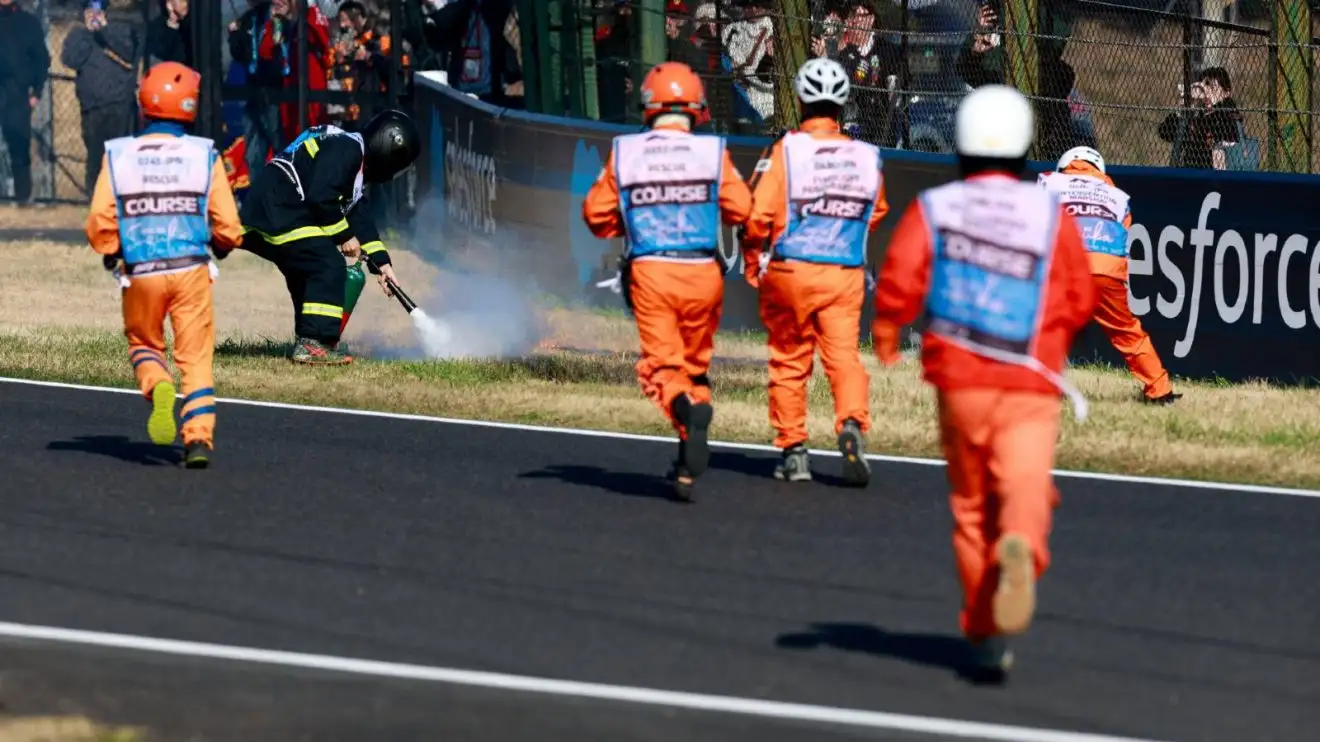
Grass Fires Disrupt Japanese Grand Prix Practice Sessions Again
The Japanese Grand Prix at Suzuka Circuit has once again faced disruptions due to unexpected grass fires during practice sessions. These incidents have raised concerns about track safety and the potential impact on the race weekend.The SunCrash.net

- Introduction
- Overview of the recurring issue of grass fires at Suzuka Circuit during the Japanese Grand Prix practice sessions.
- Historical Context of Grass Fires at Suzuka
- Previous incidents of grass fires during past Japanese Grand Prix events.
- Impact of these incidents on race schedules and safety protocols.
- Recent Incidents Leading to Disruptions
- Detailed account of the latest grass fire incidents during the current practice sessions.
- Specific locations on the track where fires occurred.
- Causes of Grass Fires During F1 Events
- Analysis of factors contributing to grass fires, such as car sparks and dry weather conditions.Reuters
- Expert insights into the mechanics of how these fires ignite.
- Analysis of factors contributing to grass fires, such as car sparks and dry weather conditions.Reuters
- Impact on Practice Sessions and Team Preparations
- Safety Measures Implemented by Race Officials
- Driver Reactions to the Disruptions
- Comparisons with Other Circuits
- Instances of similar issues at other F1 circuits around the world.
- How other venues have addressed and mitigated such problems.
- Media and Fan Reactions
- Coverage of the incidents in sports media outlets.
- Social media responses from fans and analysts.
- Potential Long-Term Solutions
- Proposals for preventing future grass fires at Suzuka Circuit.
- Technological and infrastructural changes that could be implemented.
- Impact on the Japanese Grand Prix Schedule
- Adjustments made to the race weekend schedule due to practice session delays.
- Communication from race organizers regarding these changes.
- Environmental Factors Contributing to Fire Risk
- Role of weather conditions and climate in increasing fire hazards at the circuit.
- Historical weather patterns during the Japanese Grand Prix.
- Lessons Learned from the Incidents
- Insights gained by race officials and teams from the recent grass fire events.
- How these lessons might influence future race preparations and safety protocols.
- Fan Experience and Safety Considerations
- Impact of the disruptions on the spectator experience at Suzuka Circuit.
- Measures taken to ensure fan safety during unexpected incidents.
- Conclusion
- Summary of the incidents and their implications for the Japanese Grand Prix.
- Final thoughts on the importance of addressing such issues to maintain the integrity and safety of Formula 1 events.
Introduction
The Suzuka Circuit, renowned for its challenging layout and passionate fanbase, has once again been marred by unexpected grass fires during the Japanese Grand Prix practice sessions. These incidents have not only disrupted the teams’ preparations but have also raised significant safety concerns for drivers and spectators alike. The recurrence of such events underscores the need for a thorough examination of their causes and the implementation of effective preventive measures.
Historical Context of Grass Fires at Suzuka
Grass fires at Suzuka are not a novel occurrence. In previous years, similar incidents have led to interruptions during race weekends, prompting investigations into their origins. For instance, during the 2013 Japanese Grand Prix, both Esteban Gutierrez and Jean-Eric Vergne experienced car fires during qualifying sessions, leading to significant disruptions. These historical precedents highlight a persistent issue that continues to challenge race organizers.Crash.netBBC+1BBC News+1
Recent Incidents Leading to Disruptions
The latest practice sessions at Suzuka witnessed multiple disruptions due to grass fires ignited by sparks from the cars. Notably, during the second practice session, a fire broke out between turns seven and eight, leading to a red flag situation. Despite efforts to manage the situation, a second fire erupted near the end of the session, causing further delays. These incidents have significantly impacted the flow of the practice sessions, limiting valuable track time for the teams.ReuterstalkSPORTThe Sun
Causes of Grass Fires During F1 Events
Grass fires during Formula 1 events are often attributed to sparks generated by the cars’ underbodies making contact with the asphalt. These sparks can ignite dry grass lining the track, especially under hot and arid conditions. The combination of high-speed cars, aerodynamic downforce causing bottoming out, and dry vegetation creates a conducive environment for such fires. Experts suggest that even minor sparks can lead to significant fires if the surrounding grass is sufficiently dry. Aktuelle Nachrichten | BILD.deThe SunCrash.net
Impact on Practice Sessions and Team Preparations
The interruptions caused by grass fires have a cascading effect on team preparations. Practice sessions are crucial for teams to fine-tune their car setups, assess tire performance, and strategize for qualifying and the race. Unscheduled stoppages disrupt these plans, leading to incomplete data collection and compromised preparations.
You may also like
Archives
Calendar
| M | T | W | T | F | S | S |
|---|---|---|---|---|---|---|
| 1 | 2 | 3 | 4 | 5 | 6 | 7 |
| 8 | 9 | 10 | 11 | 12 | 13 | 14 |
| 15 | 16 | 17 | 18 | 19 | 20 | 21 |
| 22 | 23 | 24 | 25 | 26 | 27 | 28 |
| 29 | 30 | 31 | ||||
Leave a Reply